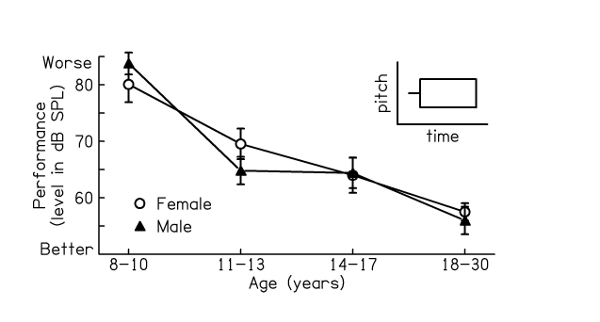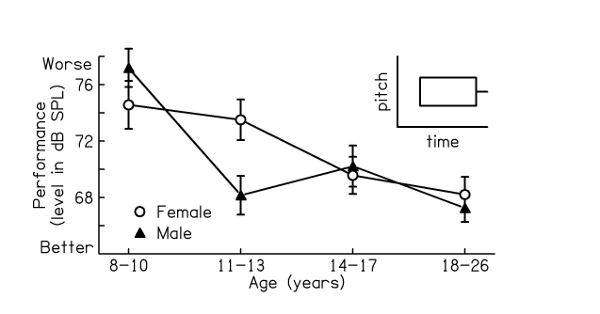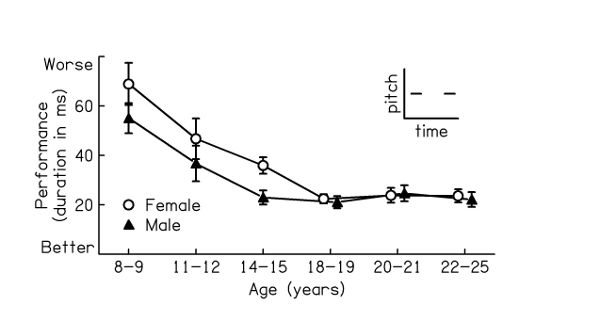Transient Sex Differences During
Adolescence on Two Auditory Skills
Julia Jones Huyck - juliajoneshuyck@u.northwestern.edu
Beverly A. Wright- b-wright@northwestern.edu
Northwestern University
Department of Communication Sciences and Disorders
Popular version of paper 4pPP14
Presented Thursday afternoon,
159th ASA Meeting,
The ability to detect the presence of sounds or to distinguish between two similar sounds improves between infancy and adulthood. We were interested in whether developmental improvements of such auditory skills occur at the same rate for males and females, particularly when these improvements continue beyond the onset of puberty. We report that some auditory abilities develop faster in males than females, though both sexes show similar performance in childhood. The more rapid maturation in males results in a transient sex difference during adolescence that does not persist into adulthood.
We tested three auditory skills in individuals ranging in
age from
Males developed more rapidly than females on two out of the three skills. However, these sex differences were apparent only during adolescence. The males did not differ from females in childhood and their faster maturation did not result in a male advantage in adulthood. Specifically, when detecting the brief tone immediately after the noise, males and females performed similarly in childhood, but males reached adult performance earlier (~12 years) than females (~15 years), resulting in a sex difference at age ~12 that resolved by age ~15 (Fig. 2). Likewise, when asked to distinguish the durations between the two brief tones, males and females did not differ from one another at 11 years of age or in adulthood, but only the males had reached mature performance by 14 years, resulting in a transient sex difference at that age (Fig. 3). This same pattern occurred on three different versions of the duration task across which the pitch of the tones or the baseline duration between the tones was varied. The ability to detect the brief tone immediately before the noise did not differ between males and females at any age and continued to improve beyond age ~15 (Fig. 1).
These data thus demonstrate faster maturation of some auditory skills in males than females. However, the difference in maturational rate was only evident during adolescence; there were no sex differences in either childhood or adulthood. These transient sex differences in adolescence may result from the massive changes in the brain that are triggered by puberty and that occur at different rates for males and females.
Sample 1. Noise alone followed by the brief tone immediately before the noise
Sample 2. Noise alone followed by the brief tone immediately after the noise
On each trial, we asked the listener to indicate whether the tone was played along with the first or second noise. In Sample 1, the noise is first played alone, then is played with the tone immediately after it. In Sample 2, the noise is first played alone and then the tone is played immediately before the noise.
Sample 3. 100-millisecond silent interval followed by 122-millisecond silent interval
On each trial, we asked the listener to indicate whether the longer interval came first or second. In Sample 3, first interval is 100 milliseconds and the second is 122 milliseconds. This difference in interval duration is equal to the average threshold for adults.

Figure 1. Performance on the task involving the detection of the brief tone immediately before the noise. Lower numbers represent better performance. Males and females never differed from one another. Mature performance was not yet achieved by ~15 years of age.

Figure 2. Performance on the task involving the detection of the brief tone immediately after the noise. Lower numbers represent better performance. Males and females differed only at ~12 years of age. Males demonstrated mature performance at age ~12, but females did not demonstrate similar performance until age ~15.

Figure 3. Performance on the task involving distinguishing the durations between the two brief tones. Lower numbers represent better performance. Males and females differed significantly only at 14-15 years of age, at which point the males had achieved mature performance, but the females had not.